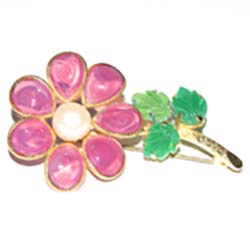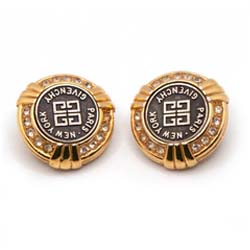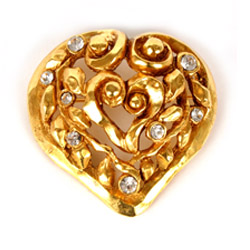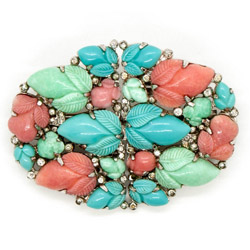Vintage Costume Jewellery Glossary of Terms
Step into a world where glamour meets whimsy, where rhinestones reign supreme, and where every piece tells a story that's as fabulous as it is fantastical. Whether you're a seasoned collector or a curious novice, this glossary will be your sparkling guide through the realm of vintage baubles and trinkets.
Antique
An object with more than 100 years of age.
Articulated
Jewellery pieces that have movable parts, typically connected by small hinges or links. This allows the piece to move and flex with the wearer's movements.
Aurora Borealis
A type of finish or coating applied to crystals to give them an iridescent or rainbow-like effect. It was popularized by Swarovski and is often used to enhance the sparkle and colour of the stones.
Bakelite
A type of early plastic used in jewellery making during the 1920s and 1930s, known for its vibrant colours and ability to be moulded into various shapes.
Bangle
A rigid bracelet that is typically circular and worn around the wrist. Bangles can be made from various materials, including metals, plastic, wood, or glass, and they come in a variety of widths and designs.
Baguette Cut
A rectangular cut with step-like facets, often used as side stones.
Base Metal
Non-precious metals such as copper, brass, or zinc that are used as a base or foundation for jewellery.
Box Chain
A chain made of square links that fit together, creating a smooth and sturdy chain.
Box Clasp
A square or rectangular-shaped clasp that snaps shut when the two sides are aligned.
Briolette
A type of gemstone cut, usually in the shape of a teardrop, with triangular or diamond-shaped facets all around the stone. Briolettes are often used as dangling elements in earrings or pendants.
Cable Chain
A chain made up of round or oval links
Cabochon
A flat-backed, smooth, domed gemstone
Cameo
A carved image, made from coral, shell, or stone with two contrasting colours
Celluloid
An early plastic used during the early 20th century. It was often used as imitation ivory or tortoiseshell.
Chaton
A pointed back, faceted, round gemstone
Cocktail Ring
A big, statement ring with a bold design. They were popular in the mid 20th century.
Costume Jewellery
Jewellery made without precious materials. Sometimes called fashion jewellery or imitation jewellery.
Curb Chain
A chain with interlocking oval links.
Demi-Parure
A set of matching jewellery smaller than a parure, usually consisting of two pieces, such as a necklace and earrings.
Dress Clip
A decorative clip that was popular during the mid-20th century. Dress clips were often used to adorn dresses and they often came as a pair.
Enamel Jewellery
Jewellery decorated with coloured glass which is fused to metal through a high-temperature firing process.
Festoon
A decorative element in jewellery design consisting of a series of suspended chains, ribbons, or strands of beads that are draped or hung in a curve-like shape.
Figaro Chain
A chain with flattened links of varying sizes, usually with longer links interspersed with shorter links.
Filigree
Delicate metalwork consisting of intricate and ornamental designs made with thin wire or twisted threads of precious metals.
Findings
The various components used in jewellery making, such as clasps, jump rings, ear wires, and connectors. Findings are essential for connecting and assembling different parts of a jewellery piece.
Fine Jewellery
Jewellery made with precious metals, such as gold, silver, or platinum, and often featuring precious gems.
Foil Back
A technique used in jewellery to enhance the brilliance and colour of gemstones. A thin layer of metal foil is placed behind a transparent gemstone to reflect light back through the stone.
French Jet
A type of black glass that was used as a substitute for jet in jewellery making.
Fruit Salad
A style of costume jewellery featuring red, green and blue stones to mimic rubies, emeralds and sapphires. These were often carved or shaped into various fruit or foliage designs. Trifari made a line of fruit salad jewellery in the 1930s made to imitate Cartier's.
Gilt
A thin layer of gold or gold colour applied to the surface of a piece of jewellery through electroplating or mechanical means.
Gold Filled
Gold plated over a base metal in a thicker coating than standard gold plating.
Gold Plating
Coating jewellery with a layer of gold.
Guilloché
A French word thought to derive from the name of an 18th century French engineer who invented a type of turning machine. This would make sense because the guilloché method involves precise patterns being turned, or engraved, onto metal which is then covered and decorated with translucent enamel (melted glass). The Scandinavians became masters of this technique in the mid 20th century.
Hook and Eye Clasp
A simple clasp consisting of a hook on one side and an eye or loop on the other.
Jet
A type of fossilized coal that has been used in jewellery making for centuries. Jet is black in colour, lightweight, and can be polished to a smooth and glossy finish.
Japanned
A type of finish, in black or dark colours, applied to metal surfaces to create a glossy or lacquered appearance. Schreiner was partial to a japanned setting.
Lobster Clasp
A spring-loaded clasp with a lever mechanism that opens and closes easily, often used in necklaces and bracelets.
Lucite
A form of acrylic often used in jewellery making, known for its light weight and vibrant colours. Employed by Trifari in their line of jelly belly jewels.
Marcasite
White iron pyrite cut and polished into small, metallic gemstones
Memory Wire
A type of wire that retains its coiled shape, often used to make adjustable bracelets or chokers. Miriam Haskell made a range of memory wire bracelets.
Mourning Jewellery
Jewellery made to memorialize a deceased loved one. It was often made with black materials such as jet, onyx, or black enamel.
Parure
A matching set of jewellery, usually consisting of a necklace, earrings, bracelet, and sometimes a brooch.
Paste
High-quality glass or crystal that is faceted and polished to resemble gemstones, often used in costume jewellery.
Patent
In the context of costume jewellery, a patent refers to the legal protection granted to a specific design, technique, or innovation used in the manufacturing of jewellery.
Pot Metal
A low-melting-point alloy, usually containing zinc, copper, and lead, used as a base metal in inexpensive jewellery.
Prong Set
A setting technique in which metal prongs secure a gemstone in place.
Quartz
A popular gemstone that belongs to the silica mineral family. It comes in various colours and is often used in jewellery making.
Rhinestone
A type of imitation gemstone made of high-quality glass or crystal that resembles a diamond or other precious stones. Rhinestones are commonly used in costume jewellery for their sparkling effect.
Rhodium Plating
Coating jewellery with a layer of rhodium, a white metal often used to enhance the appearance of silver or white gold.
Rock Crystal
A transparent form of quartz that is often used in jewellery due to its clarity and ability to be faceted or carved into various shapes.
Rolled Gold
Gold rolled in a layer over a base metal.
Rope Chain
A chain with tightly twisted strands, resembling a rope.
Sautoir
A long necklace, typically worn draped or knotted, often popular in the 1920s and 1930s.
Silver Plating
Coating jewellery with a layer of silver.
Slide Clasp
A clasp that consists of a tube or bar that slides into a corresponding slot to secure the jewellery.
Snake Chain
A flexible chain made of small, tightly linked rings, resembling the skin of a snake.
Spring Ring Clasp
A small round clasp with a spring mechanism that opens and closes by pressing a lever.
Toggle Clasp
A two-piece clasp consisting of a bar and a ring. The bar is inserted through the ring to secure the jewellery.
Tutti Frutti
A style of jewellery that originated in the Art Deco period and features a mix of colourful gemstones, typically carved or shaped into fruit, floral, or leaf motifs. See also Fruit Salad.
Vermeil
Jewellery made of sterling silver coated with a layer of gold.
Vintage
An object which is more than 20 years old.
Watermelon
A term used to describe gemstones that exhibit a colour gradient resembling the cross-section of a watermelon, with a green outer layer transitioning to a pink or red centre.




